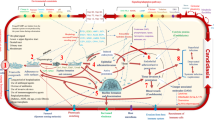Abstract
The conidial ontogenesis of the pathogenic black yeasts is studied at an ultrastructural level and their phylogenesis is discussed. Five cultures of Exophiala dermatitidis, four of E. jeanselmei, one of E. moniliae, one of E. spinifera and six of H. werneckii were observed using a scanning electron microscope.
The conidial ontogenesis of the Exophiala species is not pleomorphic but only annellidic. There are definite differences in morphology of annellated tips among the Exophiala species. The ontogenesis of Hortaea werneckii consists of a combination of sympodial and annellidic conidiogenesis. Its sympodial anamorph is unique and the annellidic anamorph is considered to be a homology of the sympodial one.
Similar content being viewed by others
References
von Arx, J. A., 1970. The genera of fungi speculating in pure culture, 1st ed. J. Cramer, Lehre, p. 180.
Borelli, D., 1978. Aureobasidium werneckii acervuli, sporodochia and pycnidia. The Black and White Yeasts, Pan American Health Organization, Sci. Publ. No. 356, Washington, DC, pp. 79–90.
Carmichael, J. W., 1966. Cerebral mycetoma of trout due to a Phialophora-like fungus. Sabouraudia 5: 120–123.
Cole, G. T., 1978. Conidiogenesis in the black yeasts. The Black and White Yeasts, Pan American Health Organization, Sci. Publ. No. 356, Washington, DC, pp. 66–78.
Grove, S. N., K. B. Oujezdsky & P. J. Szaniszlo, 1973. Budding in the dimorphic fungus Phialophora dermatitidis. J. Bacteriol. 115: 323–329.
Gustafson, R. A., R. V. Hardcastle & P. J. Szaniszlo, 1975. Budding in the dimorphic fungus Cladosporium werneckii, Mycologia 67: 942–951.
Hermanides-Nijhof, E. J., 1977. Aureobasidium and allied genera. CBS Studies in Mycology No. 15. The Black Yeasts and Allied Hyphomycetes, pp. 141–177.
de Hoog, G. S., 1977. Rhinocladiella and allied genera. CBS Studies in Mycology No. 15. The Black Yeasts and Allied Hyphomycetes, pp. 1–136.
de Hoog, G. S., 1983. On the potentially pathogenic dematiaceous Hyphomycetes. In: D. H. Howard (ed.), Fungi pathogenic for humans and animals, Part A Biology. Marcel Dekker, Inc., New York, pp. 149–216.
Horta, P., 1921. Sobre um caso de tinha preta e um novo cogumelo (Cladosporium werneckii). Revista Medico Cirurgica do Brasil 29: 267–274.
McGinnis, M. R. & L. Ajello, 1969. A new species of Exophiala isolated from channel catfish. Mycologia 66: 518–520.
McGinnis, M. R., 1977. Exophiala spinifera, a new combination for Phialophora spinifera. Mycotaxon 5: 337–340.
McGinnis, M. R. & A. A. Padhye, 1977. Exophiala jeanselmei, a new combination for Phialophora jeanselmei. Mycotaxon 5: 341–352.
McGinnis, M. R., 1977. Wangiella, a new genus to accommodate Hormiscium dermatitidis. Mycotaxon 5: 353–363.
McGinnis, M.R., D. F. Sorrell, R. L. Miller & G. W. Kaminski, 1981. Subcutaneous phaeohyphomycosis caused by Exophiala moniliae. Mycopathologia 73: 69–72.
Miyaji, M. & K. Nishimura, 1985. Conidial ontogenesis of pathogenic black yeasts and their pathogenicity for mice. Proc. Indian Acad. Sci. (Plant Sci.) 94: 437–451.
Mok, W. Y., 1982. Nature and identification of Exophiala werneckii. J. Clin. Microbiol. 16: 976–978.
Nielsen Jr., H. S. & N. F. Conant, 1968. A new human pathogenic Phialophora. Sabouraudia 6: 228–231.
Nishimura, K. & M. Miyaji, 1982. Studies on a saprophyte of Exophiala dermatitidis isolated from a humidifier. Mycopathologia 77: 173–181.
Nishimura, K. & M. Miyaji, 1983. Studies on the phylogenesis of pathogenic ‘black yeasts’. Mycopathologia 81: 135–144.
Nishimura, K. & M. Miyaji, 1984. Hortaea, a new genus to accommodate Cladosporium werneckii. Jpn. J. Med. Mycol. 25: 139–146.
Pechack, D. G. & R. E. Crang, 1977. An analysis of Aureobasidium pullulans, developmental stages by means of scanning electron microscopy. Mycologia 69: 783–792.
Sigler, L., A. Tsuneda & J. W. Carmichael, 1981. Phaeotheca and Phaeosclera, two new genera of dematiaceous hyphomycetes and a redescription of Sarcinomyces Lindner. Mycotaxon 12: 449–467.
Wang, C. J. K., 1979. Pleomorphic fungi imperfecti. In: B. Kendrick (ed.), The whole fungus, Vol. 1. The University of Waterloo Press, Waterloo, pp. 81–91.
Author information
Authors and Affiliations
Rights and permissions
About this article
Cite this article
Nishimura, K., Miyaji, M. Further studies on the phylogenesis of the genus Exophiala and Hortaea . Mycopathologia 92, 101–109 (1985). https://doi.org/10.1007/BF00444091
Issue Date:
DOI: https://doi.org/10.1007/BF00444091




